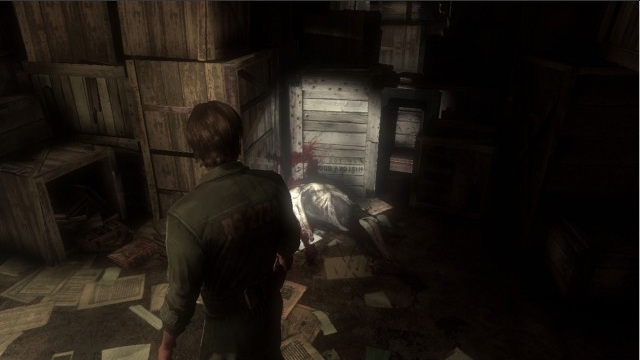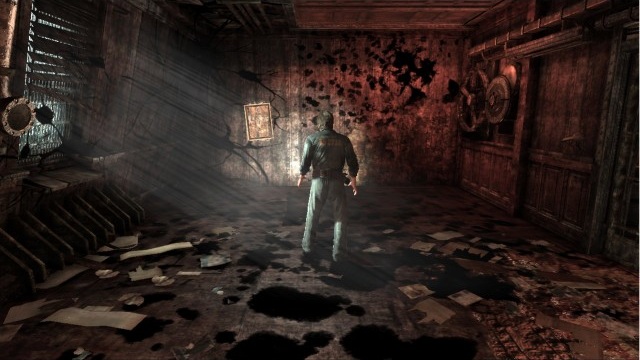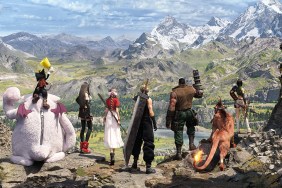The road to Silent Hill is paved with good intentions.
In the late eighties and early nineties, I could afford maybe three games a year, maybe five if my parents bought me one for birthdays or the holidays. Whether the game I got was good or bad didn't matter; my brothers and I were going to play it to the teeth. So I know that it is, in fact, possible to clear the seaweed in the dam level of Teenage Mutant Ninja Turtles on NES—we beat all 3 NES Ninja Gaiden games and played a significant portion of Battletoads before I bought something else (I could get to the snake level and no further).
In those days, with no online FAQs, we all bought game guides and shared how to beat tricky levels during group assignments in grade school. Maybe you cheated with a Game Genie to get past levels you just couldn't master. The games were all stupidly hard, frequently due to poor design, or as a holdover from the coin-op/Atari market. Silent Hill: Downpour would have done well in that kind of gaming environment. Today: Not so much.
In the first few hours it takes just to get convict Murphy Pendleton into Silent Hill, I was struck by how much the game is a throwback; at almost every point, it felt like the choice was made to go backwards instead of forwards. In some ways this is an asset to the game, but for the most part it is a detraction. In those early sections Downpour has the player going on PS1-era Resident Evil-style fetch quests, interrupted by the occasional screaming banshee monster that is so hard to kill that it's better to run. That aspect is occasionally fun, especially in a later library level that manifested as a series of lengthy puzzles. A lot of the best design takes place in the Otherworld levels, which are divided into grotesque puzzles and chase sections, where Murphy is chased through the hellish environment by a body-dissolving void.
As a whole, Downpour works best when it has tightly directed designed levels with distinct background elements. A big part of the problem here is "distinct background elements". Many of the larger environments are so monotonous that they make White on White look dynamic. This is particularly problematic when you first arrive in Silent Hill, in the residential neighborhood of Hillside.
At first the lack of direction in the huge nonlinear space and the dessicated grey, cookie-cutter home atmosphere work to enhance the mysterious and oppressive feeling of the town. Wandering around in a creepy open-world wasteland, surrounded by dense fog does the trick… for about fifteen minutes. Then the lack of direction starts to become tiresome. Then it becomes annoying and stupidly frustrating, with only the loading screen that appears after you die to give extremely vague hints at where you're supposed to go and what you are supposed to do. I didn't have a schoolyard friend to tell me how to move on, so I muddled around in frustration until I eventually gave into cursing and consulted "teh_internets" for assistance with where to go.

The game can be played fairly linearly, following only the primary story (which I did) but is clearly meant to provide an extensive amount of extra content through side missions in these large Silent Hill neighborhoods. Because of my frustration with that first area, I made a beeline for the primary objectives; it just wasn't worth it to stick around and explore. Additionally, enemies spawn regularly in these areas and Downpour's weapons—which do a very limited amount of damage—degrade over time. This was problematic in one early area where a pickaxe was necessary to clear a boarded up doorway, but the doorway was past an enemy who broke the axe when I tried to use it to block its attacks. After dispatching the enemy with a wooden stick, I had to run around the entire area for about ten minutes before the axe respawned.
The game also has technical problems. I experienced more dread over the sudden lag or framerate drop (which usually seemed to occur when new assets, like enemies, were added to the map) than with the actual scares built into the game itself. This, after a 4.5GB mandatory hard drive install… Graphically, Downpour looks a lot like an up-rezed, reskinned PS2 game, which isn't helped by the clunky cinemas. It also has frequent texture drop-in problems, with the fog in areas materializing or dematerializing; or in one of the subway areas, just appearing as a pixelated black mass at the rear of the environment, as if the game loaded a sheet of black construction paper instead of a texture.
Control-wise, it works pretty well, until you enter combat, where the camera will occasionally swing wide, away from the enemy, which has the effect of making Murphy attack in the wrong direction. A course correction isn't difficult, but it is annoying.
All of this is pretty small potatoes compared to the game's biggest problem: the autosave feature. Downpour has no manual-save function, only autosaves. However, its autosave interval is about as overly long, and worse still, any loaded saves that happen after a cut-scene are for some reason preceded by the end of the cut-scene before getting to the save. Perhaps the developers figured that players would be angrily throwing down their controllers and turning off their consoles after dying and being set-back so far, so that they would need a recap every time.

The game has six different endings, and three moral choices made throughout the game affect four of these endings. However, these moral choices don't appear to change the way the immediate gameplay or story turns out, only the ending, which makes them feel like hollow choices that rob the player of agency, instead of being empowering. It's an effect that could have worked in the game's favor by making the player feel like Silent Hill has depressingly robbed them of choice had the writing been more nuanced, but instead i just makes the design look lazy.
Silent Hill: Downpour upsets me not because it's a bad game (it is), but becaue there's the kernel of a good game in it, with some excellent set pieces that are undone by its muddy, bloated open world, technical glitches, and last-gen presentation. It's a game that I desperately want to like for what it does well, but I can't responsibly overlook its failings, which makes it all the more frustrating.
20th century novelist Thomas Wolfe wrote a book called You Can't Go Home Again, because he pissed off everyone when he wrote his first book about how messed up his hometown and family were. The survival horror genre can look to Silent Hill: Downpour as a reason that, it too, can't go home again, pointing out that the design decisions of yesteryear are no longer adequate for modern audiences. Survival horror must move forward to remain relevant. Maybe their co-op Vita game, Silent Hill: Book of Memories, will be a step in the right direction. But if Downpour shows the range of creativity applied to the series as a whole, maybe not.
-
Story is well managed for open endings
-
Does not feel like choices have real consequences
-
Linear gameplay sections are frequently fun
-
Puzzles are enjoyable, especially in the Otherworld
-
Emphasis on frustrating, vague, nonlinear areas
-
Autosave happens too infrequently, no manual save
-
Camera misdirects during combat
-
Frequent slowdown/lag, texture drop in/failure
-
Graphically anachronistic











